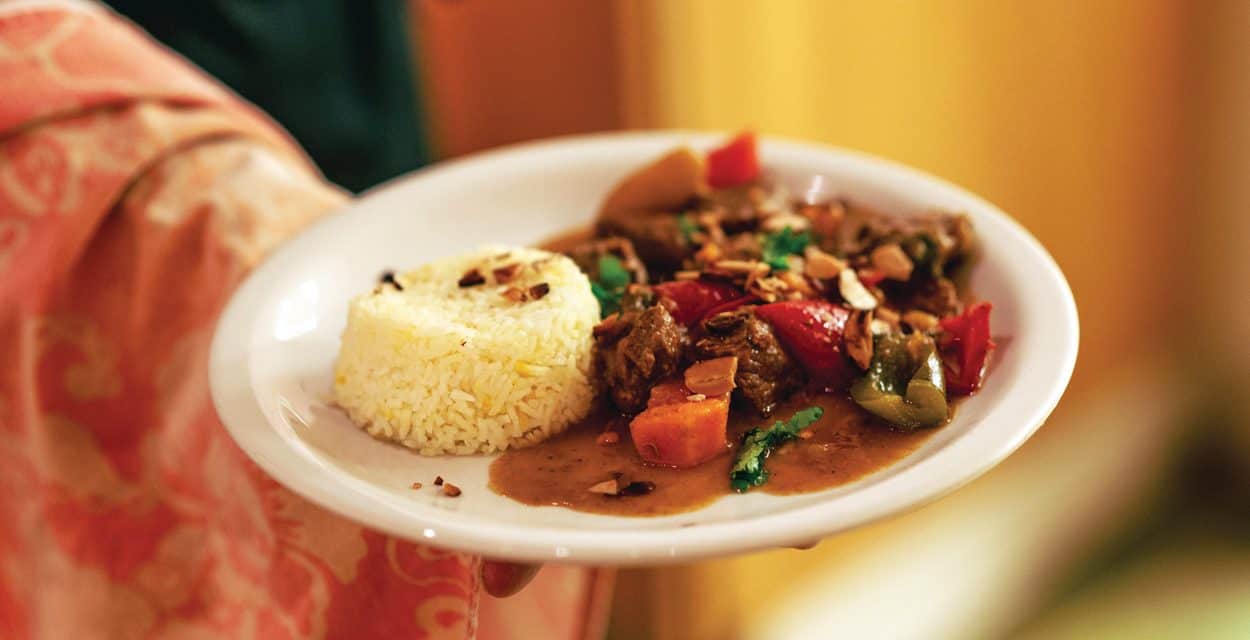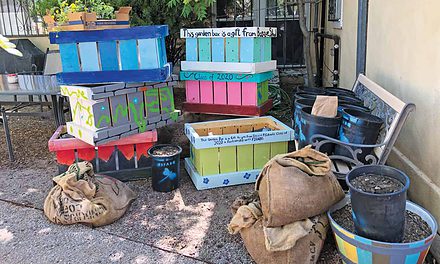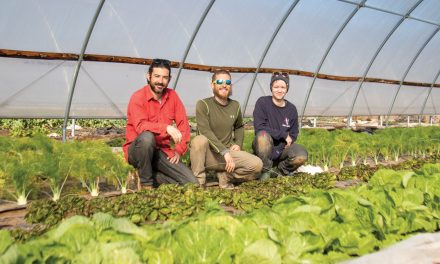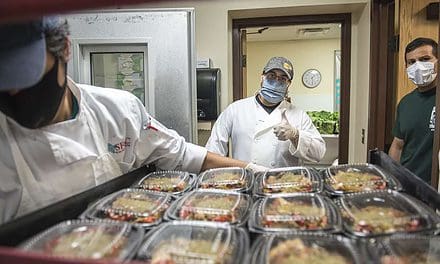A Taste of What Was, and What Could Be
By Susan DeFreitas · Photos by Koa Kalish

Churro dinner hosted by the New Mexico Fiber Arts Center
at the Los Luceros Historic Site.
On a crisp October night, I rolled up to the Los Luceros Historic Site. This Territorial-era hacienda, located on 148 acres north of Alcalde, has a rich history, dating back to the 1600s—a fitting place for the gourmet Churro dinner I was attending, offered by the New Mexico Fiber Arts Center. Because, as I would soon learn, the Churro has quite a rich history itself, and New Mexican roots that run just as deep.
I made my way through the shifting shadows of a large cottonwood in the hacienda’s courtyard, past a seasonal display of corn husks and ristras, to a warm, well-lit room in the visitor’s center, where the dinner was being hosted. Here I found an amiable collection of weavers, fiber artists, and arts aficionados, many of them in garments of great beauty. When I inquired about them, I learned that a few had woven and sewn those garments themselves.
The dinner was part of a weeklong series of events celebrating the Navajo Churro, the first sheep to come to North America by way of the Spanish conquistadors, all the way back in 1540. Nomadic Navajos acquired these sheep from Spanish colonists, and by the late sixteenth century, the Churro provided them with meat, milk, and the wool fiber used for their iconic blankets and rugs. Hispanic settlers also relied on the Churro for food and fiber, going on to develop the renowned Rio Grande weaving style—but it was the Navajos whose stocks were largely dominated by these hardy sheep.
Despite its central role in Southwest agriculture and material culture, the Churro has nearly been driven extinct twice: first in 1863 by Colonel Kit Carson and seven hundred troops under the command of General James H. Carleton, in a systematic effort to destroy all means of Navajo subsistence, and later, in the 1930s, via government land-management policies on Dine’tah that were ostensibly aimed at preserving topsoil but, in fact, privileged large cattle ranchers over small sheep ranchers, whose stock consisted primarily of Churro.
Slowly but surely, however, the Churro is being rediscovered for its many virtues. According to the Navajo Sheep Project, a nonprofit dedicated to preservation and expansion of Churro stocks, these virtues include a strong maternal instinct, abundant milk production, hardiness, excellent lamb survival rates, parasite and contagious-foot-rot resistance, and the ability to survive on “marginal feed resources.”

Lamb tagine, featuring Churro provided by Shepherd’s Lamb.
And, of course, its wool. Which is where the New Mexico Fiber Arts Center comes in.
One of my tablemates that night was Leigh Alexander, New Mexico Fiber Arts Center’s board treasurer and the director of the center’s Churro Week. As we waited for the first course to be served, she explained a bit about the history of the Churro and its resurgence in the marketplace for textiles, which began in 2013, when the wholesale blanket-weaving-production outfit Chimayó Weavers started offering blankets made with Churro wool. The next year, in an effort to expand the general recognition, appreciation, and demand for all things Churro, Churro Week was born.
Alexander was one of those whose clothing I had admired—she wore a spectacular jacket she herself had woven and sewn. Churro wool, she noted, “has a luster, it felts well, and is really durable because of the long fibers. The wool is also very warm and dense, making for a warm and fairly waterproof fabric.”
She also noted that the Churro is particularly well adapted to the Southwest, “able to eat pretty much anything,” and requires less water than other breeds, both for upkeep and processing. “It’s almost more like a goat than a sheep.”
My work as a writer is centered around the environment, and so it was not lost on me what an animal that well adapted to the Southwest might mean for food resilience in a warming world, with drier, hotter, more marginal range conditions across the West. But the key to scaling up Churro production, and strengthening the breed’s genetic stock, is capitalizing on the high market value this heritage breed’s wool can command—and, as Alexander went on to explain, even as demand for Churro wool has increased, many barriers to production remain.
There are a few sellers of Churro fleece and roving (a slightly twisted roll or strand of textile fiber) who trade in the retail and small wholesale market, but not enough for large wholesale production. Ranchers who do seek to scale up face the problem of processing: In order to keep Churro wool separate from that of other breeds, only small textile mills can be used to process it (the nonprofit Mora Valley Spinning Mill is one example). One commercial yarn retailer in Kentucky, The Woolery, carries that mill’s 100 percent Churro yarn, and the newly formed Rainbow Fiber Co-op also sells yarn spun there, using wool raised by a small number of Diné shepherds. A few other buyers and processors have the wool spun at other places. But mostly, Churro is being used on the cottage level, hand spun and used for blankets.

Textile artist Mary Grow and Chef Jean-Marc Richel
dishing up lamb tagine.
In the midst of all this talk about the Churro, our dinner began to arrive: a fresh tomato, cucumber, and chickpea salad; red lentils with spicy vegetables; Middle Eastern flatbread and olives; and a lamb tagine, featuring (of course!) Churro, provided by Shepherd’s Lamb. The chef that evening, Jean-Marc Richel, was born in France, and is clearly a lover of the cuisine of Morocco, another “marginal” agricultural region with a rich food history.
The dessert, a cardamom saffron cake, was the showstopper that evening—but it was the main course that I found myself lingering over, now that I understood something about the special history of this landrace breed. The Churro may survive in tough climate conditions, but this lamb was tender, both rich and lean and deeply savory in a spicy stew studded with apricots.
This, I understood, was more than the taste of a fine, hot stew on a crisp autumn night. This was the taste of this land and this water; the taste of small-scale ranches with deep roots in this land; a taste handed down by a people subject to the very worst abuses of colonizer culture, who not only lived to tell the tale, but to weave the tale of their own resistance into their blankets and rugs.
Recently, I’d been reading Ursula K. Le Guin’s epic Always Coming Home, a novel set in a post-collapse version of California’s Napa Valley. In this novel, the people known as the Kesh combine the most beautiful and meaningful of traditional human lifeways with appropriate but limited technology. For weeks, I’d been under the spell of this book, transported by a vision of humanity’s future that retained the best of its past.
Looking around the room that night, I was struck by the sense that such a world may be possible here in New Mexico, with its farmers and ranchers dedicated to preserving heritage breeds and seeds—with its artists and artisans who remember the essential human crafts, and the importance of beauty in our everyday lives.
And that is the world I want to live in. A world where Diné people have been reunited with the Churro, and all that this entails. A world where the Churro is here to feed us, to keep us warm, and to show us what it means to adapt to the climate we live in, and the one we will soon inhabit.
A world where skilled artisans—chefs, craftspeople, and artists—gather in their handmade finery on an autumn night to share in the bounty of the harvest.
nmfiberartscenter.org, nmhistoricsites.org/los-luceros

Susan DeFreitas
Susan DeFreitas is the author of the novel Hot Season, which won a Gold IPPY Award for Best Fiction of the West-Mountain Region, as well as a book coach and freelance editor. Before going back to school for her MFA, she was a green-tech blogger and journalist covering topics related to sustainable living. In recent years, inspired by the potentials of regenerative agriculture, she’s returned to journalism to cover sustainable agriculture. She makes her home in Santa Fe.









